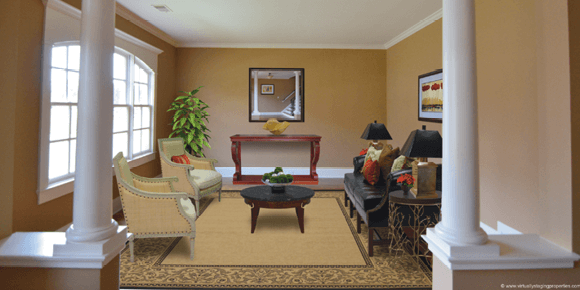Digitally added furniture takes center stage.
By Michelle Huffman
As with most computer-generated graphics, virtual staging has come a long way in a short time.
The best companies can seamlessly blend computer-generated furniture into the photograph of a room.
“There’s a big difference; if you look at the work we did when we started, it was good, but it’s not what it is today,” says Jay Bell, of Atlanta-based Virtual Staging Properties, a pioneering staging company that first rolled out virtually staged photos in 2008. “We’ve learned a lot and the work gets better literally every day.”
Virtual Staging Moves into the Spotlight
Most agents will agree that a staged room is superior to an empty one.
“When you look at a virtually staged room, even though it’s all digital furniture, compared to an empty room, there’s no question which is better,” says Grace Uhlhorn, CRS, with Keller Williams Realty in Memphis. “A staged room evokes emotions you just don’t get with a blank room.”
Uhlhorn’s husband is a builder, so staging was a clear fit with her business model. But she, like many agents, grappled with whether or not the cost and effort of staging was worthwhile. With virtual staging, the cost-benefit equation changes significantly. The obvious plus-side to virtual staging over traditional staging: It’s far cheaper.
Prices fall between $225 and $400 for three to five rooms, though it depends on the vendor, and you tend to get what you pay for, agents say. That’s about 10 percent of the cost of traditional staging, according to figures provided by agents and stagers. Oak Park, Illinois-based CRS Roz Byrne, an agent with RE/MAX in the Village, says the cost is so cheap, it’s easy to get the sellers to foot the bill.
Virtual staging also reduces the risk of damaging the property during the move. It can also be used for homes where traditional staging isn’t feasible, like a third-floor walkup, and with homes that are not empty, but have empty or under-utilized spaces, such as a finished or partially finished basement, to give buyers a sense of the room’s potential.
But not all agents feel it compares to the real thing.
Carl Medford, CRS, with Keller Williams Realty in San Francisco’s East Bay, owns his own staging company, The Next Stage, and employs the traditional method with gusto. He feels virtual staging is deceptive and impractical.
“Since I’ve worked with so many buyers over the years, I know what they want to see when they show up—especially millennials. They are so visually oriented; they need the actual furniture to be in the room when they visit so they can fully experience the home in its best light,” he says.
Because the reality of what buyers see at a showing does not match expectations, buyers get disappointed and frustrated, setting the stage for a fail, Medford says.
A staged room shows a room’s potential, without the risk of damage from moving real furniture.
Controversy Continues, but Agents Adapt
Deborah Rutter, CRS, associate broker with Nest Realty in Charlottesville, Virginia, says that her clients don’t care if the room is empty or not.
“I have to believe the controversy around it now is not about the staging itself and not about the fake furniture, it’s the deception around how it’s used,” she says. “It’s such a reasonable tool to use, but like everything else, it’s all about application. It’s all about making sure the public has a clear understanding of what they can expect.”
Most buyers and REALTORS® have experienced that sinking feeling of walking into a property and quickly realizing the house wasn’t nearly as good as the listing photos, so agents using virtual staging should try hard to avoid misrepresentation. She compares the use of virtual staging to employing a powerful wide-angle or fish-eye lens or using photo-editing software—common tactics today.
Bell encountered this concern early on, but says it’s tapered off over the years. The trick to avoiding buyer disappointment at showings is to make it clear that the homes are virtually staged.
Bell, who also owns a traditional staging company, is very clear with his clients about how the photos should be used to avoid any hint of misrepresentation. He watermarks all the virtually staged photos with his website address, asks clients to reinforce in the listing that the photos are staged and never edits any property features, such as the color of the walls or the view from a window.
Many agents also provide both a staged shot and the empty room shot in the listing. Byrne will write something like “picture the possibilities” with the photos of staged homes. She also sets up photos of the staged rooms at showings.
“My team and I have purchased a few of those digital picture frames,” Byrne says. “You plug them in and the vacant ‘before’ and virtually staged ‘after’ photos run continuously in the digital picture frame, which also serves to refresh the buyer’s memory.”
The return on investment for agents is mostly anecdotal, similar to traditional staging, but most believe that a virtually staged home moves much faster.
“If I look at other properties that have been on the market for as long as my new listing, but mine is virtually staged, mine tends to get more showings and go more quickly,” Rutter says.
5 Tips for Using Virtual Staging
Vet the virtual stager. Processes can differ from stager to stager; some are DIY and others do it all for you. Ask to see recent samples, understand the process and figure out what raw photos the stager needs.
Prepare the shot ahead of time. Bell says the best height to take a shot is between four and five feet from the floor, with a good mix of ceiling and floor.
Imagine the furniture. Shoot in a way that would best capture the room if the furniture was in it, so take a picture that would show a whole bed in a bedroom or the entire dining room table in a dining room.
Reveal reality. Many agents make it clear that the virtually staged photos are not what the buyer can expect at a showing.
Remind buyers of the possibilities. Many agents think it’s helpful to offer printouts of the virtually staged property as buyers are touring the empty rooms.








